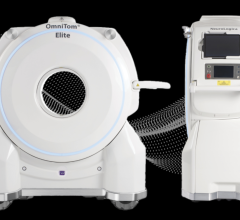Oct. 7, 2013 -- To recognize the advances in the field of nuclear and molecular imaging, as well as the professionals who carry out these procedures, the Society of Nuclear Medicine and Molecular Imaging (SNMMI) and the SNMMI Technologist Section (SNMMI-TS) celebrate Nuclear Medicine and Molecular Imaging Week, Oct. 6-12, 2013. The theme of this year’s Nuclear Medicine and Molecular Imaging Week is “Molecular Imaging: The Future … Delivered.”
The SNMMI and SNMMI-TS have compiled a list of the advances being made within the field today that will impact the future of healthcare. “The nuclear medicine and molecular imaging research currently being conducted has the potential to expand our field in a significant way and enhance ‘personalized medicine’,” noted Gary Dillehay, MD, FACNM, FACR, current president of the SNMMI. “From new imaging tracers to expanded use of radionuclide therapy to improved dose optimization, there is much to look forward to in the coming years.”
Advances being made in the field include:
- New tracers, such as 18F-FLT, 18F-FMISO and 68Ga-DOTATOC for oncology treatment monitoring.
- Expanded uses for new nuclear medicine therapies, such as 223-Radium dichloride.
- Further development of optical imaging for clinical use.
- Integration of molecular imaging into clinical trials to determine the effectiveness of treatments.
- Consensus guidelines for dose optimization in nuclear medicine procedures.
A toolkit has also been developed for nuclear and molecular imaging professionals to celebrate Nuclear Medicine and Molecular Imaging Week. The toolkit includes a fact sheet, sample letter to government officials, sample media materials and suggested activities for the week—including issuing a public service announcement, holding an open house of the nuclear and molecular imaging department for the public and hosting an appreciation luncheon for employees. Nuclear Medicine and Molecular Imaging Week t-shirts, lunch bags, pens and more are also available for purchase.
“Now more than ever, it is important that we educate others—patients, referring physicians, students, and even politicians—on the utility of nuclear medicine procedures and their benefits over other treatment and imaging modalities,” said Scott Holbrook, BS, CNMT, FSNMMI-TS, president for the SNMMI-TS. “Nuclear Medicine and Molecular Imaging Week is an opportune time to share with others the impact our field has on the well-being of patients.”
More than 17 million Americans undergo nuclear medicine procedures each year for a variety of conditions, including cancer, cardiovascular disease, neurological conditions and other physiological problems. Nuclear medicine and molecular imaging procedures are an invaluable way to gather medical information that would otherwise be unavailable, require surgery or necessitate more expensive diagnostic tests.
For more information: www.snmmi.org


 July 30, 2024
July 30, 2024 








